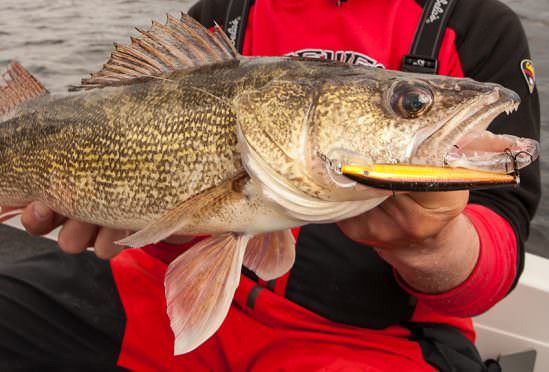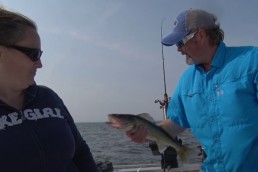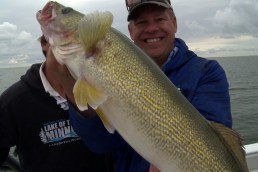Dog Days ‘Eyes on Lake of the Woods
SHARE THIS POST
The August migration of walleyes to Big Traverse
In Midwestern waters, the sultry dog days of August are a tough time to catch walleyes. The weeds are up, baitfish are prolific and tough to compete with and catching the walleyes consistently is difficult. There is an exception though, taking place on one of Minnesota’s premier walleye lakes. In fact, many target a trip to Lake of the Woods in August. You can catch fish a number of ways this time of year, but one of the absolute go-to methods for plucking these aggressive walleyes is pulling cranks.
Big Traverse Bay
The walleyes migrate to the big, open expanses of mud on Big Traverse Bay called “No Man’s Land.” There are no weeds, and No Man’s Land now is a prolific aquarium full of life. As the water warms, many of the walleyes slide to the deepest depths of this basin (30 to 35 feet of water) in search of cooler waters and less light penetration. Most importantly, there is a smorgasbord of bait in this part of the lake. Roaming schools of emerald shiners, tullibees, perch and trout perch minnows (minnows inhabiting deeper depths) are in abundance.

There are also a variety of critters that the walleyes eat, which call the mud their “home.” Bloodworms, a variety of invertebrates, and nymphs of aquatic insects are just a few. There are few “spot-on-a-spot” areas that will group walleyes tightly, so it makes sense to cover some water. And pulling crankbaits is not only a great fit, but is also effective.
Deep crankbaits and downriggers
With technology and newer products, getting a crankbait that dives 10 feet down to 35 feet has become easier. And, it’s not realistic that most anglers will have downriggers on their boats. Up at LOW, many do. Getting cranks down to the bottom foot or two of the lake in 30 to 35 feet of water, where the majority of walleyes live, is key. Downriggers are extremely effective in consistently positioning the lures in the strike zone, even when the boat surges from a wave. In other bodies of water, some may argue downriggers spook walleyes. Perhaps they do, but not here. Maybe it is the stained color of the water, but riggers always catch a ton of walleyes.
Leadcore line
Today, anglers can pick up an entire rod and line-counter reel filled with leadcore line for around $100. It’s a good option at a manageable price point for playing at these deeper depths.
Leadcore line is exactly that—line with lead as its core, which causes it to sink. The more line you let out, the deeper your crankbait will reach. Leadcore line has a different color every 10 yards. For every color of leadcore let out, your lure will go down an additional 5 feet. I really encourage anglers who may be intimidated by formulas and dive charts to keep it simple. Estimate how deep your crankbait dives; figure out how much deeper you want your lure to run. Then, let out what you believe is the amount of leadcore to get you there. Troll and watch your rod tip, and if your rod tip does start to bounce and the crankbait is hitting the mud, reel the line back in 10-foot increments until it stops. If your tip does not bounce, let out more line until it does, and you’ve found the bottom. Again, reel up line in 10-foot increments until you are not hitting the bottom. This will get you in that bottom 2 feet of the water column, right where you need to be.
There is one new product worth mentioning. Suffix has come out with a leadcore line called Suffix 832 Advanced Lead Core. It dives 30 percent deeper than traditional leadcore. For example, letting out 175 feet of traditional leadcore, you can really save a lot of reeling with only 120 feet out with the Suffix. It may not sound like much, but over the course of a day it is nice to save that 55 feet when checking fouled lures, reeling in saugers, etc.
Braided line and deep-billed crankbaits
When looking to reach depths in excess of 30 feet, some of the deep-diving crankbaits teamed up with a thin-diameter braided or superline will get down deep. If fish are hitting the bigger-billed cranks, you’re in business. If by chance you want to use smaller baits it can get tough to get down though, thus limiting lure choice, which can be a disadvantage. When the larger- billed crankbaits are going well, this method is effective.
Are you enjoying this post?
You can be among the first to get the latest info on where to go, what to use and how to use it!
Bouncers and snap weights
I had a conversation recently at a sports show with an angler who spends a time trolling the deep mud on LOW with success.
“Everyone has this fancy equipment—heck, we still use a 4-ounce bouncer with a 6- to 8-foot lead and a shallow-diving crank, and we catch all the walleyes we want,” he told me, as he laughed.
There are ways to get down, and it doesn’t have to be difficult. Just make sure to lower a bouncer slowly to avoid tangling.
Ideal crankbaits
I have literally heard anglers brag up every shape, color, wobble and brand. Here is my advice: The water is stained, meaning it has clean water, but is stained a light brown color. As a rule, gold or bright colors dominate. And gold is a staple color on Lake of the Woods. This past year, my go-to colors were gold, pink and UV pink, FireTiger and black. By raising a black crankbait up a bit, walleyes see the dark silhouette against the sunlight above. And in night fishing, dark-colored lures can rule against a shine of the moon.
When fishing with a partner, I will start us out with two different colors and wobbles. When pulling through fish I can see on the electronics, if fish aren’t responding, we’ll rotate lures, speeds and nuances until something clicks and then we hone in. Every day can be different; it’s just a matter of going out and fishing.
Nuances to get more walleyes
Recently while fishing a Minnesota Tournament Trail event using leadcore, I was reeling in a crankbait while we were trolling to check for mud, as it didn’t seem to be running right. About 25 percent of the way in, I got hit, a nice walleye. My partner noticed, so he started reeling in and letting out and reeling in as were trolling, and he got a fish. The rest of the day, we began trolling erratically, speeding up to 4 mph, dropping down to a crawl, making sharp turns and began to fill the livewell.
In another instance, I was trolling leadcore in a boat that didn’t have rod holders. Consequently, since the rod was in hand, I began jerking it forward, dropping it back, and bang, a fish. I was using a balsa wood lure and the walleyes that day wanted the lure to pause and float up and as soon as it took off again.
Every day is different, and it is up to us to figure out what they want. The point here is rather than just going in a straight line with the same crank at the same speed, mix it up and notice what happens and you can put more fish in the boat.
No equipment, no worries
There is a great option for those who don’t have the equipment, don’t want to get so involved and simply want to just relax and reel in walleyes: Jump on a charter boat. The resorts on Lake of the Woods have a large fleet of charter boats with very professional, licensed charter captains. They provide everything needed for a great day of fishing. There are really only two decisions a guest has to make in a day: what to wear and what to eat. The rest is taken care of. Resorts combine groups, making it possible to accommodate a single person up to groups of six.
August in many parts are a time to put down the fishing pole and wait for the fall bite. But in these waters, it’s a time many anglers look forward. Now is a time to grab your poles, a handful of cranks and get after it.
MWO
SHARE THIS POST
Did you enjoy this post?
You can be among the first to get the latest info on where to go, what to use and how to use it!
Joe Henry
Tournament angler and licensed charter captain Joe Henry fishes and hunts the Midwest. Henry is a media member of AGLOW and writes for numerous publications, creates videos, appears on a variety of outdoor TV and radio shows and is a frequent seminar speaker. Henry is the Executive Director of Lake of the Woods Tourism.



